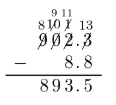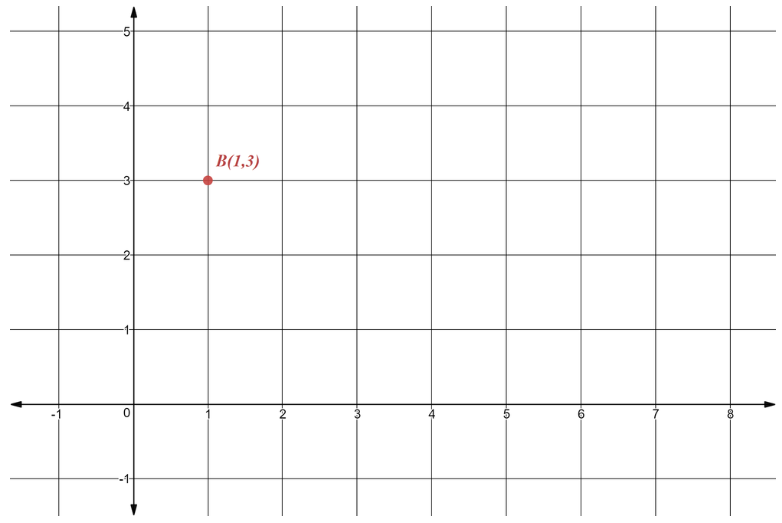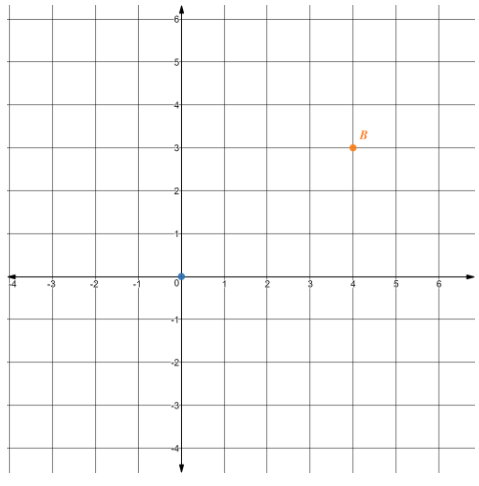Chapter 2 Integers And Rational Numbers
Section 2.2: Represent Rational Numbers On The Number Line
Page 71 Exercise 1a Answer
A seagull’s position relative to the sea level is desribed by a positive fraction, that is by \(\frac{3}{4}\), thus he is \(\frac{3}{4}\) of a yard above the sea level.
A dolphin’s position relative to the sea level is desribed by a negative fraction, that is by –\(\frac{1}{4}\), thus it’s position is \(\frac{1}{4}\) of a yard below the sea level.
A shark’s position relative to the sea level is desribed by a negative decimal number, that is by −0.5, which is equal to –\(\frac{1}{2}\), that is half of a yard. Thus it’s position is half of a yard below the sea level.
A sea turtle’s position relative to the sea level is desribed by a negative integer, that is by −1, thus it’s position is 1 below the sea level.
Result
The seagull is \(\frac{3}{4}\) of a yard above the sea level. The dolphin is \(\frac{1}{4}\) of a yard below the sea level. The shark is half of a yard below the sea level. The sea turtle is 1 yard below the sea level.
Read And Learn More: enVisionmath 2.0 Grade 6 Volume 1 Solutions
Page 71 Exercise 1b Answer
The positions of the animals are \(\frac{3}{4}\), –\(\frac{1}{4}\), −1, and −0.5 so we need to plot points at these values on the number line.
Since all of the numbers can be written in terms of fourths, it helps to divide the given number line into fourths and then plot the points:

Result
Plots points at \(\frac{3}{4}\), –\(\frac{1}{4}\), -0.5 and −1 on the number line.
Page 71 Exercise 1 Answer
Representing the locations of negative fractions and decimals is similar to representing the locations of positive fractions and decimals since both can be represented as points on a number line. The difference is that negative fractions and decimals are plotted as points to the left of 0 on the number line while positive fractions and decimals are plotted as points to the right of 0.
Page 72 Exercise 1 Answer
Writing –\(\frac{5}{4}\) and -1.75 as mixed numbers gives:
\(-\frac{5}{4}=-\left(\frac{4}{4}+\frac{1}{4}\right)=-\left(1+\frac{1}{4}\right)=-1 \frac{1}{4}\)
\(-1.75=-1 \frac{75}{100}=-1 \frac{3}{4}\)
Since both numbers are in terms of fourths, divide the given number line into fourths. Then plot points at both values.
It is helpful to rename –\(\frac{5}{4}\) and −1.75 as mixed numbers when plotting these points because it is easier to locate their positions. If we know the location as a mixed number, we can move on the number line to the integer part of the mixed number and then move to the fractional part.

Result
\(-\frac{5}{4}=-1 \frac{1}{4} \quad-1.75=-1 \frac{3}{4}\)
It is helpful to rename –\(\frac{5}{4}\) and −1.75 as mixed numbers when plotting these points because it is easier to locate their positions. If we know the location as a mixed number, we can move on the number line to the integer part of the mixed number and then move to the fractional part.
Page 73 Exercise 2 Answer
The given numbers are -0.75, \(\frac{2}{3}\), and 1.75.
Since −0.75 is negative, \(\frac{1}{4}\) is to the right of it. Since 1.75 is greater than one and \(\frac{1}{4}\) is less than one, it is to the left of it.
To compare \(\frac{2}{3}\) and \(\frac{1}{4}\) rewrite them as fractions with the same denominator.
\(\frac{2}{3}=\frac{2 \times 4}{3 \times 4}\)
= \(\frac{8}{12}\)
\(\frac{1}{4}=\frac{1 \times 3}{4 \times 3}\)
= \(\frac{3}{12}\)
\(\frac{8}{12}\) is greater than \(\frac{3}{12}\), thus \(\frac{1}{4}\) is put to the left of it.
\(\frac{1}{4}\) is placed between −0.75 and \(\frac{2}{3}\).
Result
\(\frac{1}{4}\) is placed between −0.75 and \(\frac{2}{3}\).
Page 73 Exercise 3 Answer
We need to compare −3° and −7°.
To compare negative integers, we can compare their absolute values. The number with the larger absolute value is the smaller number. Since −7 has a larger absolute value than −3, then −3° > −7°.
Since −7° is smaller than −3°, then the temperature at midnight was colder than the temperature at 10:00 P.M.
Result
−3° > −7° so the temperature at midnight was colder than the temperature at 10:00 P.M.
Page 74 Exercise 1 Answer
To plot, compare, and order rational numbers using a number line, first plot a point at each rational number on the number line. Then compare their locations. The farther left the point is, the smaller the rational number is. The order of the rational numbers from least to greatest is then the same order that their points lie on the number line.
Page 74 Exercise 2 Answer
A rational number is any number which can be written as a fraction, that is as \(\frac{a}{b}\) or –\(\frac{a}{b}\) where a and b are integers and b ≠ 0. Since every whole number n can be written as a fraction where \(\frac{n}{1}\), every whole number is also a rational number.
For example, 15 can be written as \(\frac{15}{1}\) which is \(\frac{a}{b}\) where a = 15 and b = 1, thus it is a rational number.
Result
Every whole number n can be written as a fraction where \(\frac{n}{1}\) so every whole number is also a rational number. For example, 15 can be written as \(\frac{15}{1}\) which is \(\frac{a}{b}\) where a = 15 and b = 1, thus it is a rational number.
Page 74 Exercise 3 Answer
A rational number is any number which can be written as a fraction, that is as \(\frac{a}{b}\) or –\(\frac{a}{b}\) where b are integers and b ≠ 0. Since every integer n can be written as a fraction where \(\frac{n}{1}\), every integer is also a rational number.
For example, −15 can be written as –\(\frac{15}{1}\) which is \(\frac{a}{b}\) where a = −15 and b = 1, thus it is a rational number.
Result
Every integer n can be written as a fraction where \(\frac{n}{1}\), so every integer is also a rational number. For example, −15 can be written as –\(\frac{15}{1}\) which is \(\frac{a}{b}\) where a = −15 and b = 1, thus it is a rational number.
Page 74 Exercise 4 Answer
The inequality −4°C > −9°C states that −4°C is greater than −9°C, that is, −4°C is warmer than −9°C.
Page 74 Exercise 5 Answer
The point A is positioned at –\(\frac{1}{2}\) since it is halfway between −1 and 0.
Result
–\(\frac{1}{2}\)
Page 74 Exercise 6 Answer
The point B is positioned \(\frac{3}{4}\)
Result
\(\frac{3}{4}\)
Page 74 Exercise 7 Answer
The point C is positioned at –\(1 \frac{3}{4}\)
Result
–\(1 \frac{3}{4}\)
Page 74 Exercise 8 Answer
Plot a point at –\(1 \frac{1}{4}\) by moving to -1 on the number line and then moving an additional fourth to the left. Then label the point as P:

Result
Plot a point a –\(1 \frac{1}{4}\) and then label the point as P.
Page 74 Exercise 9 Answer
Plot a point at 0.25 by moving one fourth to the right of 0. Then label the point as Q:

Result
Plot a point at 0.25 and then label the point as Q.
Page 74 Exercise 10 Answer
Plot a point at −0.75 by moving three quarters to the left of 0. Then label the point as R:

Result
Plot a point at −0.75 and then label the point as R.
Page 74 Exercise 11 Answer
Plot a point at –\(\frac{1}{4}\) by moving one fourth to the left of 0. Then label the point as S:

Result
Plot a point at –\(\frac{1}{4}\) and then the point as S.
Page 74 Exercise 12 Answer
To order the numbers 1.25, 1.25, –\(\frac{3}{2}\), -1.25, \(1 \frac{1}{2}\) from least to greatest using the number line, we first need to plot the points on the number line.
The order of the numbers from least to greatest is the same as the order that they lie on the number line. The numbers in order from least to greatest is then:
\(-\frac{3}{2},-1.25,1.25,1 \frac{1}{2}\)

Result
\(-\frac{3}{2},-1.25,1.25,1 \frac{1}{2}\)

Result
Open to see the solution.
Page 74 Exercise 13 Answer
To order the numbers −0.5, \(\frac{1}{2}\), −0.75, and \(\frac{3}{4}\) from least to greatest using the number line, we first need to plot the points on the number line.
The order of the numbers from least to greatest is the same as the order that they lie on the number line. The numbers in order from least to greatest is then:
\(-0.75,-0.5, \frac{1}{2}, \frac{3}{4}\)

Result
\(-0.75,-0.5, \frac{1}{2}, \frac{3}{4}\)
Page 74 Exercise 14 Answer

Result
Open to see the solution.
To order the numbers −1.5, −0.75, −1, and 2 from least to greatest using the number line, we first need to plot the points on the number line.
The order of the numbers from least to greatest is the same as the order that they lie on the number line. The numbers in order from least to greatest is then:

Result
−1.5, −1, −0.75, 2
Page 75 Exercise 15 Answer
The point A is positioned at –\(3 \frac{1}{4}\).
Result
–\(3 \frac{1}{4}\)
Page 75 Exercise 16 Answer
The point B is positioned at –\(4 \frac{1}{2}\).
Result
–\(4 \frac{1}{2}\)
Page 75 Exercise 17 Answer
The point C is positioned at \(1 \frac{1}{4}\).
Result
\(1 \frac{1}{4}\)
Page 75 Exercise 18 Answer
The point D is positioned at –\(5 \frac{3}{4}\).
Result
–\(5 \frac{3}{4}\)
Page 75 Exercise 19 Answer
The point E is positioned at \(\frac{1}{2}\).
Result
\(\frac{1}{2}\)
Page 75 Exercise 20 Answer
The point F is positioned at –\(2 \frac{1}{2}\).
Result
–\(2 \frac{1}{2}\).
Page 75 Exercise 21a Answer
Plot a point halfway between -6 and -5 to plot the number –\(5 \frac{1}{2}\) on the number line.

Result
Plot a point halfway between -6 and -5 on the number line to plot –\(5 \frac{1}{2}\).

Result
Open to see the solution.
Page 75 Exercise 21b Answer
The number line is divided into tenths so to plot −6.3 on the number line, go to −6 and then move 3 tenths to the left:

Result
Go to −6 on the number line and then move 3 tenths to the left to plot −6.3.

Result
Open to see the solution.
Page 75 Exercise 21c Answer
The number line is divided into tenths so to plot −5.8 on the number line, go to −5 and then move 8 tenths to the left:

Result
Go to −5 on the number line and then move 8 tenths to the left to plot −5.8.

Result
Open to see the solution.
Page 75 Exercise 21d Answer
The number line is divided into tenths so to plot –\(6 \frac{7}{10}\) on the number line, go to −6 and then move 7 tenths to the left:

Result
Go to −6 on the number line and then move 7 tenths to the left to plot –\(6 \frac{7}{10}\).

Result
Open to see the solution.
Page 75 Exercise 21e Answer
The number line is divided into tenths so to plot −4.9 on the number line, go to −5 and then move 1 tenth to the right:

Result
Go to −5 on the number line and then move 1 tenth to the right to plot −4.9.

Result
Open to see the solution.
Page 75 Exercise 21f Answer

Result
Open to see the solution.
Page 75 Exercise 21f Answer
The number line is divided into tenths so to plot –\(6 \frac{9}{10}\) on the number line, go to −7 and then move 1 tenth to the right:

Result
Go to −7 on the number line and then 1 tenth to the right to plot –\(6 \frac{9}{10}\).
Page 75 Exercise 22a Answer
Since \(\frac{1}{10}\) can be written as 0.1, it is greater than 0.09. That is \(\frac{1}{10}\) > 0.09.
Result
\(\frac{1}{10}\) > 0.09.
Page 75 Exercise 22b Answer
Rewrite both numbers as fractions.
\(-1.44=-1+0.44=-1 \frac{44}{100}=\frac{-144}{100}\)
\(-1 \frac{1}{4}=\frac{-5}{4}=\frac{-125}{100}\)
Since \(\frac{-144}{100}<\frac{-125}{100}\),
-1.44 < –\(1 \frac{1}{4}\).
Result
-1.44 < –\(1 \frac{1}{4}\).
Page 75 Exercise 22c Answer
To compare –\(\frac{2}{3}\) and -0.8, it helps to compare them in the same form.
Rewriting -0.8 as a fraction gives:
\(-0.8=-\frac{8}{10}=-\frac{4}{5}\)
Now that both numbers are written as fractions, we can rewrite them to have a common denominator:
\(-\frac{2}{3}=-\frac{2 \times 5}{3 \times 5}=-\frac{10}{15}\)
\(-\frac{4}{5}=-\frac{4 \times 3}{3 \times 5}=-\frac{12}{15}\)
Since \(-\frac{10}{12}>-\frac{12}{15}, \text { then }-\frac{2}{3}>-0.8\)
Result
\(-\frac{2}{3}>-0.8\)
Page 75 Exercise 22d Answer
We need to compare 0.5 and \(\frac{2}{4}\).
Converting 0.5 to a fraction and then reducing gives:
0.5 = \(\frac{5}{10}\) = \(\frac{1}{2}\)
Reducing \(\frac{2}{4}\) gives \(\frac{1}{4}\).
Since 0.5 and \(\frac{2}{4}\) both equal \(\frac{1}{2}\) both equal \(\frac{1}{2}\), then 0.5 = \(\frac{2}{4}\)
Result
0.5 = \(\frac{2}{4}\)
Page 75 Exercise 22e Answer
We need to compare –\(2 \frac{3}{4}\) and −2.25.
It helps to compare the numbers when they are in the same form so rewrite 2 – \(\frac{3}{4}\) as a decimal:
–\(2 \frac{3}{4}\) = –\(2 \frac{75}{100}\) = −2.75
Since −2.75 < −2.25, then –\(2 \frac{3}{4}\) < −2.25.
Result
–\(2 \frac{3}{4}\) < −2.25
Page 75 Exercise 22f Answer
We need to compare –\(\frac{3}{5}\) and −0.35.
Its helps to compare the numbers in the same form so rewrite –\(\frac{3}{5}\) as a decimal:
–\(\frac{3}{5}\) = –\(\frac{6}{10}\) = −0.6
Since −0.6 < −0.35, then –\(\frac{3}{5}\) < −0.35.
Result
–\(\frac{3}{5}\) < −0.35
Page 75 Exercise 23a Answer
We need to order the numbers −6, 8, −9, and 13 from least to greatest.
Negative numbers are always smaller than positive numbers so −6 and −9 are the smallest numbers and 8 and 13 are the largest numbers.
To compare negative numbers, you can compare their locations on a number line. The farther left the number is on the number line, the smaller the number is. Since −9 would be plotted farther left on a number line, then −9 < −6:
−9,−6, _, _
Since 8 < 13, then the order of the numbers is:
−9, −6, 8, 13
Result
−9, −6, 8, 13
Page 75 Exercise 23b Answer
We need to order the numbers –\(\frac{4}{5}\), –\(\frac{1}{2}\), 0.25, and −0.2 from least to greatest.
Negative numbers are always smaller than positive numbers so 0.25 is the largest number:
_, _, _,0.25
Rewriting the negative numbers to decimal form gives:
\(-\frac{4}{5}=-\frac{8}{10}=-0.8\)
\(-\frac{1}{2}=-\frac{5}{10}=-0.5\)
Since -0.8 < -0.5 < -0.2, then –\(\frac{4}{5}\) < –\(\frac{1}{2}\) < −0.2. The order of the numbers from least to greatest is then:
–\(\frac{4}{5}\), –\(\frac{1}{2}\), −0.2, 0.25
Result
–\(\frac{4}{5}\), –\(\frac{1}{2}\), −0.2, 0.25
Page 75 Exercise 23c Answer
We need to order the numbers 4.75, –\(2 \frac{1}{2}\), –\(\frac{8}{3}\), and \(\frac{9}{2}\) from least to greatest.
Negative numbers are always smaller than positive numbers so –\(2 \frac{1}{2}\) and –\(\frac{8}{3}\) are the smallest numbers and 4.75 and \(\frac{9}{2}\) are the largest numbers.
Rewriting the negative numbers to have a common denominator gives:
\(-2 \frac{1}{2}=-\frac{5}{2}=-\frac{15}{6}\)
\(-\frac{8}{3}=-\frac{16}{6}\)
Since \(-\frac{16}{6}<-\frac{15}{6}\), then \(-\frac{8}{3}<-2 \frac{1}{2}\)
–\(\frac{8}{3}\), –\(2 \frac{1}{2}\), _, _
Since \(\frac{9}{2}\) = \(\frac{45}{10}\) = 4.5 and 4.5 < 4.75, then \(\frac{9}{2}\) < 4.75. The order of the numbers is:
–\(\frac{8}{3}\), –\(2 \frac{1}{2}\), \(\frac{9}{2}\), 4.75
Result
–\(\frac{8}{3}\), –\(2 \frac{1}{2}\), \(\frac{9}{2}\), 4.75
Page 75 Exercise 23d Answer
We need to order the numbers 4, −3, −8, and −1 from least to greatest.
Negative numbers are always smaller than positive numbers so 4 is the largest number:
_, _, _, 4
To compare negative numbers, you can compare their locations on a number line. The farther left the number is on the number line, the smaller the number is. The order of the negative numbers on the number line from left to right is −8, −3, −1 so the order of the numbers is:
−8,−3,−1,4
Result
−8,−3,−1,4
Page 75 Exercise 24 Answer
Since all natural numbers are also whole numbers, positive integers, and rational numbers, we only need 1 point to give an example of a natural number, whole number, positive integer, and rational number.
If we also need an example of a negative integer, then the least number of points is 2.
For example, we can plot a point at 5 as an example of a natural number, whole number, positive integer, and rational number and the point −4 to have an example of a negative integer.
Result
Since a natural number is also a whole number, positive integer, and rational number, the least number of points is 2. One point represents a negative integer and the other represents a natural number, whole number, positive integer, and rational number.
Page 76 Exercise 25 Answer
Since all the numbers are negative, the point that is farthest from 0 on the number line is the point that is farthest to the left on a number line.
–\(2 \frac{1}{4}\) is the farthest left since it is left of −2 while all the other numbers are to the right of −2. Therefore, the fanfin anglerfish is farthest from 0 on the number line.
Result
fanfin anglerfish
Page 76 Exercise 26 Answer
To determine which animal is closest to a depth of -0.7 km, we need to compare each location in decimal form to see which one is closest to -0.7.
–\(2 \frac{1}{4}\) and -1.1 are not close to -0.7 since they don’t lie between -1 and 0 while -0.7 does. We can then ignore those locations.
-0.8 and -0.6 are both 0.1 away from -0.7.
–\(\frac{3}{10}\) = -0.3 so it is 0.4 away from -0.7.
Dividing 2 and 3 to two decimal places gives:

Rounding to the nearest tenth then gives –\(\frac{2}{3}\) ≈ -0.7 so it is about 0 away from -0.7.
Therefore, –\(\frac{2}{3}\) is the closest to -0.7 so the deep sea anglerfish has a depth closest to -0.7 km.
Result
deep sea anglerfish
Page 76 Exercise 27 Answer
It is given that the change in the value of the stock is −5.90.
Since the change is negative, this means the value of the stock decreased.
A change in the value of −5.90 then means {the value of the stock decreased $5.90}$.
Result
The value of the stock decreased $5.90.
Page 76 Exercise 28 Answer
It is given that the classmate ordered the numbers from greatest to least as:
4.4, 4.2, −4.42, −4.24
The classmate is not correct. When ordering negative numbers, you need to compare how far left each number is from 0 on a number line. The negative number that is farther left is the smallest number. Since −4.42 is farther left than −4.24, then −4.42 < −4.24. The correct order is then:
4.4, 4.2, −4.24, −4.42
Result
The classmate is incorrect because the negative numbers are not in the correct order. The correct order is 4.4, 4.2, −4.24, −4.42.
Page 76 Exercise 29 Answer
We need to order the numbers \(-3.25,-3 \frac{1}{8},-3 \frac{3}{4} \text {, and }-3.1 \text {. }\)
Rewriting the mixed numbers to decimal form gives:
\(-3 \frac{1}{8}=-3 \frac{125}{1000}=-3.125\)
\(-3 \frac{3}{4}=-3 \frac{75}{100}=-3.75\)
Since -3.75 < -3.25 < -3.125 < -3.1, then the order of the numbers from least to greatest is:
\(-3 \frac{3}{4},-3.25,-3 \frac{1}{8},-3.1\)
Result
\(-3 \frac{3}{4},-3.25,-3 \frac{1}{8},-3.1\)
Page 76 Exercise 30 Answer
It is given that \(\frac{a}{b}\), \(\frac{c}{d}\) and \(\frac{e}{f}\) are rational numbers such that \(\frac{a}{b}\) is less than \(\frac{c}{d}\) and \(\frac{c}{d}\) is less than \(\frac{e}{f}\).
Since \(\frac{a}{b}\) is less than \(\frac{c}{d}\), we can write \(\frac{a}{b}\) < \(\frac{c}{d}\).
Since \(\frac{c}{d}\) is less than \(\frac{e}{f}\), we can write \(\frac{c}{d}\) < \(\frac{e}{f}\).
Combining the inequalities gives \(\frac{a}{b}\) < \(\frac{c}{d}\) < \(\frac{e}{f}\).
We can then conclude that \(\frac{a}{b}\) < \(\frac{e}{f}\)
Result
Since \(\frac{a}{b}\) < \(\frac{c}{d}\) < \(\frac{e}{f}\), then \(\frac{a}{b}\) < \(\frac{e}{f}\).
Page 76 Exercise 31 Answer
Choice A: Since \(4 \frac{1}{2}\) = \(\frac{9}{2}\) = \(\frac{18}{4}\), which is not greater than \(\frac{25}{4}\), then choice A is NOT true.
To verify our answer, we should check the other answer choices.
Choice B: Since –\(4 \frac{1}{2}\) = –\(\frac{18}{4}\), which is greater than –\(\frac{25}{4}\), then –\(4 \frac{1}{2}\) > –\(\frac{25}{4}\) is true.
Choice C: −6 < −5 is a true statement since −6 lies to the left of −5 on a number line.
Choice D: –\(\frac{1}{2}\) < \(\frac{1}{2}\) is true since negative numbers are always smaller than positive numbers.
Result
A. \(4 \frac{1}{2}\) > \(\frac{25}{4}\)
Page 76 Exercise 32 Answer
If the numbers 1.2, 0, n, –\(\frac{1}{5}\) are listed from greatest to least, then n must be a number between 0 and –\(\frac{1}{5}\). That is, n must be a negative number and n > –\(\frac{1}{5}\).
Since n must be negative and bigger than –\(\frac{1}{5}\), then it must be a negative fraction with a denominator that is bigger than 5.
The correct answer choice is then D. –\(\frac{1}{6}\)
Result
D. –\(\frac{1}{6}\)











































































































